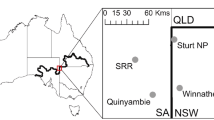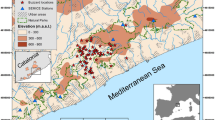Summary
Synchronous declines of sympatric shrew and microtine populations in boreal regions of Fennoscandia have been claimed as evidence that predation deepens and extends the low phase of the microtine population cycles. Assuming that shrews and microtines have the same maximum intrinsic rate of increase, and that the predators kill the shrews and microtines that they encounter unselectively, this hypothesis predicts that sympatric shrew and microtine populations will decline and increase simultaneously. In this study conducted at 60°56′N in southeast Norway, as well as in 13 of 15 other studies at sites in Fennoscandia, the shrew populations declined simultaneously with the sympatric microtine populations, but recovered sooner. The shrew-microtine ratio among animals trapped peaked about 2 years after the peak in the microtine population. The same pattern was found in the diet of raptors in Fennoscandia. Since the maximum intrinsic rate of increase does not seem to be higher in shrews than in microtines, the pattern suggests that either predation is not causing the extended lows in the microtine populations, or that the proportion of predators that selectively kill microtines fluctuates during the microtine cycle. The most likely candidates for selective killers are weasels.
Similar content being viewed by others
References
Andersson M, Jonasson S (1986) Rodent cycles in relation to food resources on an alpine heath. Oikos 46:93–106
Angelstam P, Lindström E, Widén P (1984) Role of predation in short-term population fluctuations of some birds and mammals in Fennoscandia. Oecologia (Berlin) 62:199–208
Beacham TD (1979) Selectivity of avian predation in declining populations of the vole Microtus townsendii. Can J Zool 57:1767–1772
Bednarz JC, Dinsmore JJ (1985) Flexble dietary and feeding ecology of the red-shouldered hawk, Buteo linneatus, in Iowa. Can Field Nat 99:262–264
Boonstra R (1977) Predation on Microtus townsendii populations: impact and vulnerability. Can J Zool 55:1631–1643
Christensen H (1985) Biotopvalg, adferd og næring hos rev (Vulpes vulpes L.) vinterstid i et barskogområde på Østlandet. Cand real thesis Univ of Oslo (in Norwegian)
Day MG (1968) Food habits of British stoats (Mustela erminea) and weasels (Mustela nivalis). J Zool (London) 155:485–497
Duncan N (1976) Theoretical aspects concerning transmission of the parasite Skrjabingylus nasicola (Leuckart 1842) to stoats and weasels with a review of the literature. Mamm Rev 6:63–74
Erlinge S (1975) Feeding habits of the weasel Mustela nivalis in relation to prey abundance. Oikos 26:378–384
Erlinge S, Göransson G, Hansson L, Högstedt G, Liberg O, Nilsson IN, Nilsson T, Schantz T von, Sylvén M (1983) Predation as a regulating factor on small rodent populations in southern Sweden. Oikos 40:36–52
Fitzgerald BM (1977) Weasel predation on a cyclic population of the montane vole (Microtus montanus) in California. J Anim Ecol 46:367–397
Goszczynski J (1977) Connections between predatory birds and mammals and their prey. Acta Theriol 22:399–430
Hansson I (1967) Transmission of the parasitic nematode Skrjabingylus nasicola (Leuckart 1842) to species of Mustela (Mammalia). Oikos 18:247–252
Hansson L (1984) Predation as the factor causing extended low densities in microtine cycles. Oikos 43:255–256
Hansson L, Henttonen H (1985) Gradients in density variations of small rodents: the importance of latitude and snow cover. Occologia (Berlin) 67:394–402
Hansson L, Löfqvist J, Nilsson A (1978) Population fluctuations in insectivores and small rodents in northernmost Fennoscandia. Z Säugtierk 43:75–92
Henttonen H (1985) Predation causing extended low densities in microtine cycles: further evidence from shrew dynamics. Oikos 45:156–157
Hestbeck JB (1987) Multiple regulation states in populations of small mammals: a state-transition model. Am Nat 129:520–532
Holmberg T (1976) Variationer i kattugglans (Strix aluco) bytesval. Fauna Flora 71:97–107 (in Swedish with summary in English)
Hörnfeldt B (1987) Basinventering gnagare (BIG). Rapport 21. Inst Ekol Zool Univ Umeå (in Swedish)
Hörnfeldt B, Löfgren O, Carlsson B-G (1986) Cycles in voles and small game in relation to variations in plant production indices in Northern Sweden. Oecologia (Berlin) 68:496–502
Jaksic FM (1983) The trophic structure of sympatric assemblages of diurnal and nocturnal birds of prey. Am Midl Nat 109:152–162
Jaksic FM, Braker HE (1983) Food-niche relationships and guild structure of diurnal birds of prey: competition versus opportunism. Can J Zool 61:2230–2241
Janes SW, Barss HN (1985) Predation by three owl species on northern pocket gophers of different body mass. Oecologia (Berlin) 67:76–81
Järvinen A (1987) Microtine cycles and plant production: what is cause and effect? Oikos 49:352–357
Kaikusalo A, Hanski I (1985) Population dynamics of Sorex araneus and S. caecutiens in Finnish Lapland. Acta Zool Fenn 173:283–285
Kellomäki E (1977) Food of the Pygmy Owl Glaucidium passerinum in the breeding season. Ornis Fenn 54:1–29
Korpimäki E (1981) On the ecology and biology of Tengmalm's Owl Aegolius funereus. Acta Univ Oul A 118 Biol 13:1–84
Korpimäki E (1985a) Rapid tracking of microtine populations by their avian predators: possible evidence for stabilizing predation. Oikos 45:281–284
Korpimäki E (1985b) Prey choice strategies of the kestrel Falco tinnunculus in relation to available small mammals and other Finnish birds of prey. Ann Zool Fenn 22:91–104
Korpimäki E (1986) Predation causing synchronous decline phases in microtine and shrew populations in western Finland. Oikos 46:124–127
Korpimäki E, Norrdahl K (1987) Low proportion of shrews in the diet of small mustelids in western Finland. Z Säugetierk 52:257–260
Krebs CJ, Myers JH (1974) Population cycles in small mammals. Adv Ecol Res 8:267–399
Laine K, Henttonen H (1983) The role of plant production in microtine cycles in northern Fennoscandia. Oikos 40:407–418
Lehmann U, Halle S (1987) Circadian activity patterns, photoperiodic responses and population cycles in voles. II: Photoperiodic responses and population cycles. Oecologia (Berlin) 71:573–576
Lindroth RL, Batzli GO (1986) Inducible plant chemical defences: a cause of vole population cycles? J Anim Ecol 55:431–449
Marks JS (1984) Feeding ecology of breeding long-eared owls in southwestern Idaho. Can J Zool 62:1528–1533
McNab BK (1980) Food habits, energetics, and the population biology of mammals. Am Nat 116:106–124
McNab BK (1983) Energetics, body size, and the limits to endothermy. J Zool (London) 199:1–29
Murie A (1936) Following fox trails. Misc Publs Mus Zool Univ Mich 32:1–45
Myllymäki A, Christiansen E, Hansson L (1977) Five-year surveillance of small mammal abundance in Scandinavia. EPPO Bull 7:385–396
Nams VO (1981) Prey selection mechanisms of the ermine (Mustela erminea). In: Chapman JA, Pursley D (eds) Worldwide furbearer conference proceedings. Donneley, Falls Church, Va., pp 861–882
Nyholm E (1959) Stoats and weasels and their winter habitats. In: King CM (ed) Biology of mustelids: Some Soviet research. Brit Libr Lending Div 1975, Yorks., pp 118–131
Pankakoski E (1985) Relationships between some meteorological factors and population dynamics of Sorex araneus in southern Finland. Acta Zool Fenn 173:287–289
Pearson OP (1966) The prey of carnivores during one cycle of mouse abundance. J Anim Ecol 35:217–233
Pearson OP (1971) Additional measurements of the impact of carnivores on California voles (Microtus californicus). J Mamm 52:41–49
Phelan FJS, Robertson RJ (1979) Predatory responses of a raptor guild to changes in prey density. Can J Zool 56:2565–2572
Roberts HL, Bowman N (1986) Diet and ecology of short-eared owls Asio flammeus breeding on heather moor. Bird Study 33:12–17
Rubina MA (1960) Some f% ltures of the weasel (Mustela nivalis) ecology based on observations in the Moscov region. Byull Mosk Ova Ispyt Prir Otd Biol 65:27–33
Siegel S (1956) Nonparametric statistics for the behavioral sciences. McGraw-Hill Kogakusha, Tokyo
Skarén U (1972) Fluctuations in small mammal populations in mossy forests of Kuhmo, eastern Finland, during eleven years. Ann Zool Fenn 9:147–151
Sokal RR, Rohlf FJ (1969) Biometry. Freeman, San Francisco
Solheim R (1984) Caching behaviour, prey choice and surplus killing by pygmy owls Glaucidium passerinum during winter, a functional response of a generalist predator. Ann Zool Fenn 21:301–308
Sonerud GA (1980) Jaktstrategier hos flyvende småpattedyr-predatorer i barskog. Cand real thesis Univ of Oslo (in Norwegian)
Sonerud GA (1986) Effect of snow cover on seasonal changes in diet, habitat, and regional distribution of raptors that prey on small mammals in boreal zones of Fennoscandia. Holarct Ecol 9:33–47
Steenhof K, Kochert MN (1985) Dietary shifts of sympatric buteos during a prey decline. Oecologia (Berlin) 66:6–16
Suomus H (1952) Studies on the feeding habits of the common buzzard. Riistat Julk 8:121–127 (in Swedish with summary in English)
Wabakken P (1985) Vinternæring, habitatbruk og jaktadferd hos mår (Martes martes) i sørøst-norsk barskog. Cand real thesis Univ of Oslo (in Norwegian)
Author information
Authors and Affiliations
Rights and permissions
About this article
Cite this article
Sonerud, G.A. What causes extended lows in microtine cycles?. Oecologia 76, 37–42 (1988). https://doi.org/10.1007/BF00379597
Received:
Issue Date:
DOI: https://doi.org/10.1007/BF00379597




